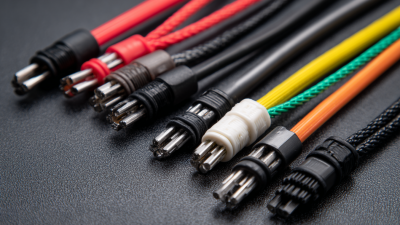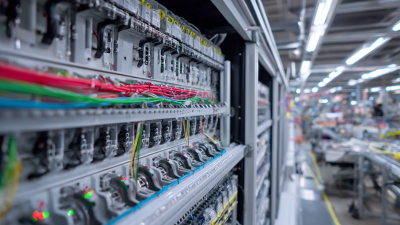 In today's fast-paced technological landscape, the demand for efficient and reliable cable harness design has reached unprecedented levels. According to a recent market report by ResearchAndMarkets, the global cable assembly market is projected to grow at a CAGR of 5.6% from 2021 to 2026, driven by the rising integration of advanced electronics in automotive, aerospace, and consumer sectors. This highlights the urgent need for innovative solutions that enhance the optimization of cable harness design, allowing manufacturers to minimize costs and improve performance simultaneously. By utilizing digital tools and best practice methodologies, companies can streamline production processes, reduce errors, and ultimately create more sophisticated and compact harness systems that meet rigorous industry standards. The future of cable harness design promises advancements that not only address current challenges but also set new benchmarks for efficiency and reliability in the industry.
In today's fast-paced technological landscape, the demand for efficient and reliable cable harness design has reached unprecedented levels. According to a recent market report by ResearchAndMarkets, the global cable assembly market is projected to grow at a CAGR of 5.6% from 2021 to 2026, driven by the rising integration of advanced electronics in automotive, aerospace, and consumer sectors. This highlights the urgent need for innovative solutions that enhance the optimization of cable harness design, allowing manufacturers to minimize costs and improve performance simultaneously. By utilizing digital tools and best practice methodologies, companies can streamline production processes, reduce errors, and ultimately create more sophisticated and compact harness systems that meet rigorous industry standards. The future of cable harness design promises advancements that not only address current challenges but also set new benchmarks for efficiency and reliability in the industry.
In the realm of cable harness design, innovation is key to enhancing efficiency and performance. Recent studies indicate that the global market for cable harnesses is projected to reach $57.89 billion by 2025, reflecting a compound annual growth rate (CAGR) of 5.5%. As industries demand more sophisticated wiring solutions, manufacturers are increasingly turning to advanced design optimization techniques.
One notable approach involves the use of computer-aided design (CAD) software integrated with simulation tools. Reports show that utilizing these technologies can reduce design time by up to 30%, allowing engineers to visualize and test harness layouts before physical prototyping. Additionally, the adoption of 3D modeling has improved the accuracy of space utilization, ultimately leading to a reduction in weight and material costs. Another strategy gaining traction is the implementation of modular cable harness designs, which enable quicker assembly processes and adaptability to different applications, significantly increasing productivity.
As the demand for lightweight and compact designs grows, the integration of artificial intelligence (AI) in cable harness design is also on the rise. AI technologies can analyze vast amounts of data from past projects, helping designers predict potential issues and optimize layouts for efficiency. This not only accelerates the design phase but also results in higher reliability and performance in the final product, a critical requirement in today's competitive landscape.
In the realm of cable harness design, the evolution of techniques has been marked by significant advancements that differentiate traditional approaches from modern methodologies. Traditional design techniques often rely on manual drafting, leading to longer development cycles and a higher margin for error. These methods prioritize the physical layout and often constrain innovation, as they are heavily dependent on the designer's individual experience and intuition. As a result, traditional processes can struggle with scalability and the integration of new technologies.

Conversely, modern design techniques leverage sophisticated software tools and automation, enabling designers to optimize layouts with greater precision and efficiency. Computer-Aided Design (CAD) platforms, paired with advanced simulation tools, allow for real-time adjustments and complex modeling that were previously unattainable. This shift not only accelerates the design process but also enhances the overall performance of cable harnesses by allowing for better heat distribution, weight reduction, and space optimization. By embracing these modern techniques, engineers can meet the demands of contemporary applications while staying agile in an ever-evolving market landscape.
The cable harness design process has evolved significantly with the advent of advanced software tools that facilitate optimization and efficiency. According to a recent report by IDC, companies that implement specialized design software can enhance their design efficiency by up to 40%. These tools not only streamline the wiring layout process but also reduce potential errors, which can lead to costly redesign phases. The integration of 3D modeling and simulation features allows engineers to visualize the harness in a virtual environment, enabling them to spot conflicts and design flaws early in the process.
Moreover, the impact of automation in software tools cannot be understated. A study by TechValidate revealed that organizations utilizing automated design tools report a decrease in lead times by an impressive 30%. These tools offer enhanced capabilities such as real-time data analysis and collaboration features, which improve communication among team members. Consequently, companies can make more informed decisions, resulting in prototypes that better meet market demands and compliance standards. By leveraging these technological advancements, organizations are not only able to improve design efficiency but also reduce costs and accelerate time-to-market for their products.

In the realm of cable harness design, pursuing cost-effective optimization strategies is paramount. A thorough cost-benefit analysis can reveal the most efficient paths to enhance performance while minimizing expenses. For instance, employing advanced simulation tools can identify potential design flaws early in the process, saving time and resources that would otherwise be spent on modifications during production. Investing in such technologies often pays dividends by streamlining workflows and mitigating lengthy delays.
Tip: When evaluating optimization strategies, consider the long-term implications of your initial investments. Sometimes, higher upfront costs for more sophisticated tools can lead to significant savings in the later stages of design and manufacturing.
Additionally, collaborating with cross-functional teams can provide diverse perspectives that enhance the design process. This multidisciplinary approach enables the integration of insights from various stakeholders, resulting in more robust solutions. Involving engineers, manufacturers, and even end-users in the design discussions not only fosters innovation but also ensures that the final product aligns with practical needs.
Tip: Encourage open communication during the design phase, as insights from different departments can highlight potential issues and inspire creative solutions before they escalate into costly problems.
In the ever-evolving landscape of cable harness design, innovative solutions have emerged, driven by real-world success stories that showcase the effectiveness of optimization strategies. One prominent example is the collaboration between an automotive manufacturer and a specialized design firm that re-engineered their cable harness system to reduce weight and improve efficiency.
By employing advanced materials and 3D modeling techniques, the team was able to streamline the routing of cables, resulting in a 20% reduction in overall harness weight, which directly enhanced vehicle performance and fuel efficiency.
Another notable case is within the aerospace industry, where precision and reliability are paramount. A leading aerospace company implemented a modular design approach for their cable harnesses, allowing for easier assembly and maintenance.
By incorporating feedback from field engineers during the design phase, the company was able to identify critical pain points and address them effectively. This iterative process led to a significant decrease in production time and a marked improvement in the harness's performance in extreme conditions, thereby ensuring compliance with rigorous safety standards.
These case studies illustrate how targeted innovations can lead to transformative results in cable harness design, ultimately driving substantial benefits for manufacturers and consumers alike.







